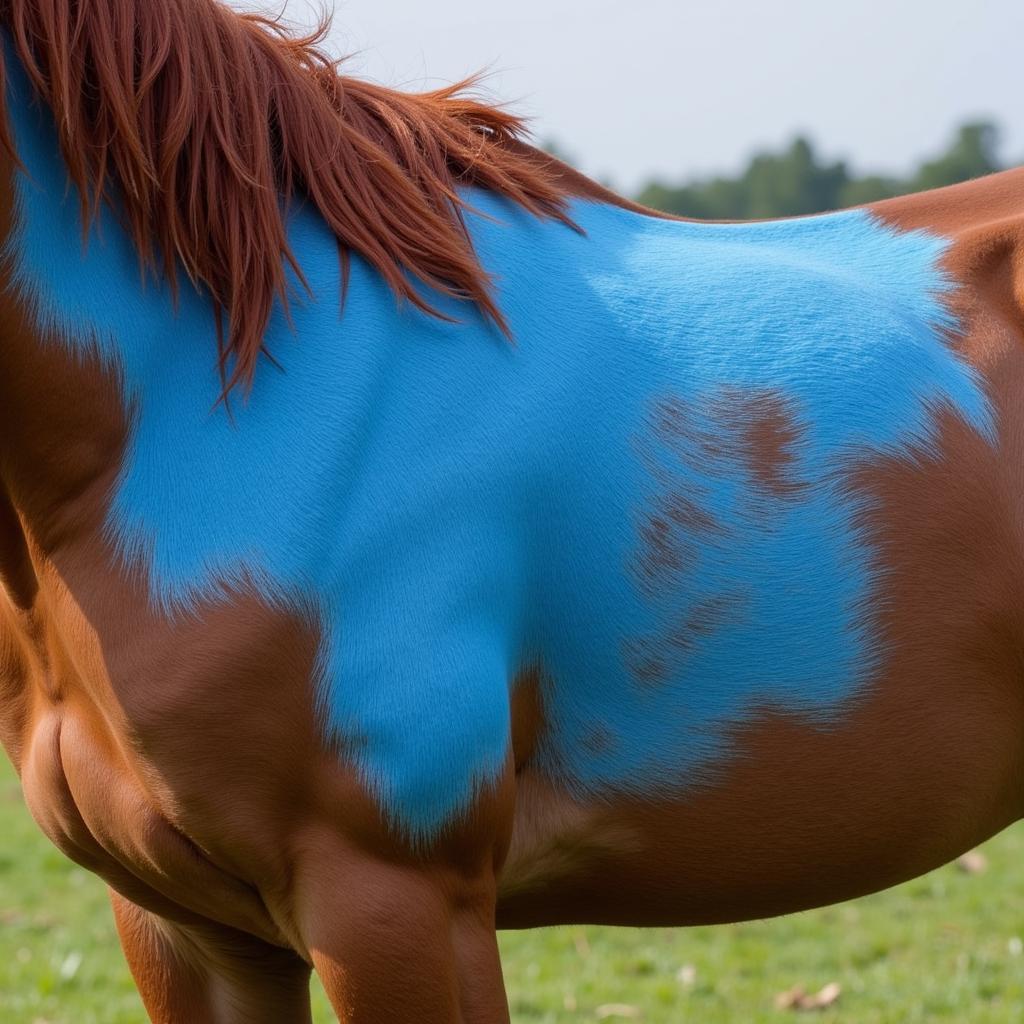Blue kote, also known as gentian violet, is a common antiseptic used for horses and other animals. This vibrant purple solution is effective against various bacterial and fungal infections, making it a staple in many equine first-aid kits. This guide explores the uses, benefits, and precautions of using Blue Kote For Horses.
Understanding Blue Kote and its Uses for Horses
Blue kote is a topical antiseptic known for its distinctive deep purple color. Its active ingredient, gentian violet, is a dye with antifungal and antibacterial properties. For horses, blue kote is commonly used to treat minor cuts, scrapes, abrasions, ringworm, thrush, and other skin infections. It creates a protective barrier over the affected area, preventing further contamination and promoting healing.
When Should You Use Blue Kote on Your Horse?
Blue kote is particularly effective for superficial wounds and skin irritations. Common uses for horses include:
- Minor Cuts and Abrasions: Blue kote helps prevent infection and promotes healing in minor cuts and scrapes.
- Ringworm: Its antifungal properties make it a useful treatment for ringworm infections in horses.
- Thrush: Blue kote can be applied to the frog of the hoof to treat thrush, a bacterial infection.
- Rain Rot: It can help control the spread of rain rot, a bacterial skin infection common in horses exposed to wet conditions.
Applying Blue Kote: A Step-by-Step Guide
Applying blue kote correctly is crucial for effective treatment and to avoid staining surrounding areas. Follow these steps:
- Clean the Affected Area: Gently clean the wound or infected area with warm water and a mild antiseptic soap. Remove any dirt or debris.
- Dry the Area: Pat the area dry with a clean towel.
- Apply Blue Kote: Use a cotton swab, gauze pad, or a small brush to apply a thin layer of blue kote directly to the affected area. Avoid applying it to healthy skin surrounding the wound.
- Allow to Dry: Let the blue kote dry completely before bandaging or allowing the horse back into its stall or pasture.
Important Precautions When Using Blue Kote
While blue kote is generally safe, there are some precautions to keep in mind:
- Staining: Blue kote stains skin, clothing, and tack. Wear gloves when applying it and cover surrounding areas to prevent unwanted staining.
- Sensitivity: Some horses may be sensitive to blue kote. If you notice any signs of irritation, such as redness, swelling, or excessive itching, discontinue use and consult your veterinarian.
- Deep Wounds: Blue kote is intended for superficial wounds. Do not use it on deep punctures or lacerations. These require professional veterinary attention.
- Ingestion: Keep blue kote out of reach of horses and other animals. Ingestion can cause digestive upset.
 Horse with Treated Rain Rot
Horse with Treated Rain Rot
“Blue kote is a valuable tool in any horse owner’s first-aid kit,” says Dr. Emily Carter, DVM, equine veterinarian with over 20 years of experience. “Its antiseptic and antifungal properties make it effective for treating a range of common skin conditions.”
Blue Kote vs. Other Antiseptics
While blue kote is a popular choice, other antiseptic options are available for horses. These include:
- Iodine: Effective against bacteria and fungi, but can be irritating to some horses.
- Chlorhexidine: A broad-spectrum antiseptic that is less likely to stain than blue kote.
- Hydrogen Peroxide: Useful for cleaning wounds but can damage healthy tissue if used repeatedly.
“When choosing an antiseptic for your horse,” advises Dr. Carter, “consider the type of wound or infection, the horse’s sensitivity, and the potential for staining.”
Conclusion
Blue kote is a versatile and effective antiseptic for horses, offering a valuable solution for treating minor skin ailments. By understanding its proper application and precautions, horse owners can effectively utilize blue kote to maintain their horses’ health and well-being. Remember to consult with your veterinarian for any serious injuries or infections.
FAQ
- How often should I apply blue kote to my horse? Typically, once or twice a day until the wound or infection shows signs of improvement.
- Will blue kote stain my horse’s coat permanently? No, the stain will eventually fade, but it can take several weeks or months.
- Can I use blue kote on a pregnant mare? Consult your veterinarian before using blue kote on a pregnant or lactating mare.
- What should I do if my horse ingests blue kote? Contact your veterinarian immediately.
- Can blue kote be used on open wounds? Yes, for superficial wounds. Deeper wounds require veterinary care.
- Is blue kote safe for use around a horse’s eyes? Use caution and consult your vet. Avoid direct contact with the eyes.
- Where can I purchase blue kote for my horse? At most feed stores, tack shops, and online retailers specializing in equine supplies.
Need further support? Contact us at Phone: 0772127271, Email: [email protected] or visit our location: QGM2+WX2, Vị Trung, Vị Thuỷ, Hậu Giang, Việt Nam. We have a 24/7 customer support team. Check out our other articles on horse care and first aid on JustusHorsesUSA.com.